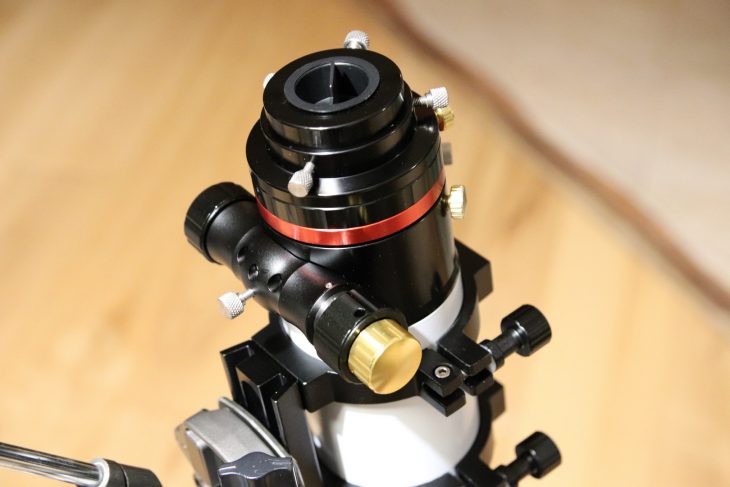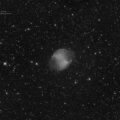71SDQ first look

TS Optics 71SDQ quadruplet refractor is somehow new product targeted mainly for portable astroimaging. It seems to be successor of well known quadruplet 65Q, and since their basic parameters are very similar, it may be also considered as a direct replacement for 65Q.
| Parameter | TS 71SDQ | TS 65Q |
|---|---|---|
| Aperture [mm] | 71 | 65 |
| Focal ratio | 1/6.3 | 1/6.5 |
| Focal length [mm] | 450 | 420 |
| Instrument length [mm] | 370 | 340 |
| Instrument weight (with rings) [kg] | 2.5 | 2.8 |
According to manufacturer this instrument is equipped with air spaced front aperture lens made with FPL-53 glass. Front lens does not have collimation screws, but for quadruplet with integrated flattener it is understandable – there is not much the end user can do here to adjust optics collimation. The distance between optical elements (second one is inside tube near to focuser) and its relative positioning must be set with good accuracy.
Refractor is pretty compact, when dewcap is retracted it is only 37cm long. It is also quite lightweight, but due to its small size it seems to be little bit weighty. Lens hood can be pulled out, but not much, about 5-6cm only. CNC made tube rings are of good quality, and there is also short Vixen style dovetail included.
Focuser
Focuser in 71SDQ quadruplet is standard TS Optics rack&pinion model with 2.5 inches diameter. It is pretty good quality and should be perfectly enough for imaging with DSLR camera or small and medium sized dedicated astrocameras. Focuser tube travel is about 55mm. There is 360 degrees rotator at the end of the focuser tube. It is pretty stiff and there is no visible play in this element. Rotator from the camera side is ended with standard M61x1 thread that holds reduction to 2″ and to 1.25″ holders, so you can basically attach any standard accessories you have. One thing worth to mention is that bottom side of focuser shaft cover is not flat, but fancy shaped, so standard adapters to focusing motors will probably not fit that.
Focuser maximum travel is 55mm and this is too short for example to catch focus with DSLR using only 2″ or T2 adapter ring put into 2″ clamping ring. You may order special adapter attached directly to M63x1 thread, or use at least 15mm extender.
Quadruplet 71 SDQ under the sky

I have caught two hours of clear skies, although the Moon was shining pretty high then. At start I put 24mm ES 68 degrees eyepiece (19x power) into 2″ dielectric diagonal. The views offered by this instrument were very pleasant. Stars were pinpoint, star clusters were well defined, and star colors were easily distinguishable. Trapezium in M42 at this low power was separated to four components. After changing eyepiece to BCO 10mm (45x power) the view of M42 was much better, because background has been darkened and amount of detail increased. At this power Castor double star (separation 5″) was already seen as double star. With BCO 6mm eyepiece (75x power) Castor was completely split to two components. Slightly defocused stars presented clear diffraction rings, and when defocused more, the stars images were uniform discs of light. See below – defocused images of 25um artificial star.

Moon was best viewed with BCO 10mm eyepiece. Detail level was quite high, and seeing influence was easily visible.


To be continued…
Related posts:
7 Comments
Leave a Reply to Mireia Cancel reply
This site uses Akismet to reduce spam. Learn how your comment data is processed.









I am just getting into astrophotography at 18, and i have done countless hours of research, and i found this scope. I was wanting to know how good is this scope or would you recommend another one under $1000?
Hi Caleb,
This is pretty good instrument, and its main advantage is easy of use (due to integrated flattener). Still under 1000$ you should get popular 80mm aperture triplet with dedicated flattener. These triplets are available at f/6 and f/7 and are sold under different brands, like Stellarvue SV80 or TS Photoline as well.
Lucas
Hi 🙂 Can you recommend any adaptor set of that M63 to Canon that allows to use M48 filters? How much back focus does the recommended M63 to M48 allow?
Hello! Unfortunately not – I have not seen anything like this 🙁 Maybe it needs to be built with few other elements?
I asked Rafa (rafcamera) to design one, just in case someone finds it interesting: rafcamera.com/adapter-m63x1f-to-m48x0-75m
Thanks Mireia! However this is not direct M63 to Canon adapter – you still need to have M48 to EOS adapter.
Well, yes, but it allows for filters screwed just like in other refractors such as the redcat. If you use a DSLR, that’s a difference with respect to the standard M63 to M48 adaptor 😉